Battles of Lexington and Concord
![]()
This article or section needs revision. More details should be given on the discussion page. Please help improve it, and then remove this tag.
Battles of Lexington and Concord
Part of: American War of Independence
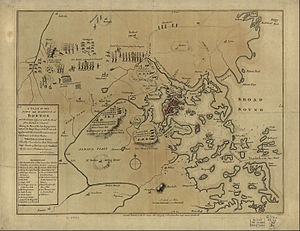
Map of the Siege of Boston and the Battles of Lexington and Concord
American War of IndependenceNorthern
Campaign
Lexington and Concord, Boston, Bunker Hill, Long Island, Kips Bay, Harlem Heights, Pell's Point, White Plains, Fort Washington, Trenton I, Trenton II, Princeton
The battles of Lexington and Concord were the first battles of the American War of Independence. They were fought on April 19, 1775, in the Massachusetts towns of Lexington, Concord, Lincoln, Menotomy, and Cambridge. The battles marked the beginning of the armed conflict between Great Britain and the thirteen colonies.
Synopsis
About 700 British Army regulars under the command of Lieutenant Colonel Francis Smith were ordered to seize or destroy military supplies reportedly stored in Concord by Massachusetts militia. Weeks earlier, the American rebels had received warning of the impending British search operation through espionage and had moved virtually all of the supplies to safety. The rebels had also learned details of the British plans the night before the battle and quickly passed them on to the militia.
The first shots were fired in an engagement at Lexington during the British advance. However, the militia was outnumbered and took flight. Other militiamen fought three companies of royal soldiers at the Old North Bridge in Concord. The British units broke formation and fled after a heated battle.
Over the next few hours, more Minutemen arrived and inflicted heavy casualties on the British soldiers returning from Concord. Smith's expedition, on returning to Lexington, was reinforced by soldiers under General Hugh Percy and extricated from their difficult position. The two British detachments, with a combined 1700 soldiers, marched back toward Boston, coming under heavy fire. They finally made a successful tactical retreat upon reaching Charlestown.
The British failed to achieve the secrecy and speed necessary for successful action in enemy territory. In addition, they failed to destroy a significant amount of weapons and supplies. However, most of the soldiers managed to return to Boston unharmed. The occupation of the surrounding area by the Massachusetts militia was accompanied by the beginning of the siege of Boston.
The battles are known in America as "the shot heard 'round the world" and were described in Ralph Waldo Emerson's Concord Hymn. They are regularly re-enacted at Minute Man National Historical Park.
The battles
Lexington
When the advancing British troops under the command of Pitcairn arrived in Lexington at sunrise on April 19, 1775, about 60 militiamen led by Captain John Parker came out of Buckman Tavern, waited on the village green, and watched the arriving soldiers. About 40 to 100 spectators stood along the road. Parker told his militiamen not to retreat or fire and to let the army march by unmolested.
Instead of turning left into Concord, Lieutenant of Marines Jesse Adair, at the head of the three companies, independently decided to swing first to the right to protect his own flank and then march two companies onto the village green itself. Thereupon the men ran to Lexington's militia and also took line in battle, shouting "Huzzah!" Major Pitcairn himself came forward, waving his sword and shouting, "Disperse, you rebels; be damned, throw down your arms and scatter!" Captain Parker ordered his men to disperse, but some did not hear him, some went away very slowly, and no one laid down his arms. Both Parker and Pitcairn ordered not to fire, but some one fired a shot.
Some of the Regulars' witnesses reported that the first shot was fired by an American bystander from behind a hedge or corner of a building in the tavern. Some of the Lexington militiamen, in turn, testified that a mounted British officer fired first. Both agreed that none of the foot soldiers facing each other had fired.
Eyewitnesses reported several shots from both sides before the Regulars began firing volleys without orders. Some of the militiamen at first believed the Regulars were just firing powder without bullets, but then they realized the gravity of the situation and returned fire. Pitcairn's horse was hit twice. The Regulars made a bayonet charge. Captain Parker saw his cousin Jonas stabbed to death. Eight Massachusetts men were killed and ten wounded. The British reportedly had only one lightly wounded. The eight Americans killed, the first military casualties of the American Revolution, were John Brown, Samuel Hadley, Caleb Harrington, Jonathon Harrington, Robert Munroe, Isaac Muzzey, Jonas Parker, and Ashahel Porter. Jonathon Harrington, mortally wounded by a bullet, was able to crawl back to his home and died on the doorstep. Prince Estabrook, a black slave, served in the Lexington militia and was also wounded in the skirmish on the village green.
The infantry under Pitcairn were beyond the control of the officers. They were firing in different directions and trying to get into houses. Then the main body marched into the town, and Colonel Smith restored order. The British regrouped, fired a winning shot, gave three cheers, and continued on their way to Concord.
Concord
The older militiamen of Concord advised caution until reinforcements arrived from surrounding towns. The middle-aged men wanted to stay and defend the town. The younger men of the Minutemen wanted to go east and attack the British army from higher ground. As the Regulars approached, each of the three groups acted on their own ideas. The Minutemen watched from a hill as Smith had the light infantry aligned against them. They then retreated marching into the town. The older men, as well as those of middle age, had taken a hill in the town and were discussing what to do next, while the Minutemen, pursued by the Regulars, were coming toward them. Now the militia from Lincoln also arrived and joined in the discussion. The older men were able to prevail. Colonel Barrett ordered a retreat from the town and led the men across the Old North Bridge to a hill about a mile and a half outside the town. From there they could watch the British troop movements.
The Regulars are following Gage's orders...
Smith's soldiers were divided into a variety of units to carry out Gage's orders. One company of light infantry secured the south bridge in the process, and seven companies of light infantry secured the Old North Bridge near the militiamen. Of these seven companies, four companies were sent to search Barrett's property about 3 kilometers on the other side of the bridge, and two more companies of the 4th and 10th Regiments of Foot continued to guard the bridge.
The grenadiers searched the place for military supplies. Pitcairn threatened a Patriot leader with his pistol until he led him to three buried cannons. Pitcairn then paid him for a breakfast. Further, the grenadiers burned some cannon teams they found in the village, and when the fire spread to the adjoining building, residents and soldiers together formed a fire chain to save the building. About 100 barrels of flour and 250 kg of bullets were thrown into the mill pond. The bullets were recovered the following day.
Barrett's house had been an arsenal for the previous weeks, but now only a few weapons remained. These, moreover, had been concealed. The troops sent there marched that day more than any others, and they found nothing but a breakfast, which some soldiers demanded of Mrs. Barrett.
North Bridge
Colonel Barrett's militiamen saw the smaller units directly in front of them and, after obtaining an opinion, concluded to march to a flat hill about 300 yd (274 m) from the Old North Bridge. This land belonged to Major John Buttrick, the leader of Barrett's Minutemen units and was also their drill ground. There was still a British company there, but they retreated to the bridge without a fight as Barrett's men approached.
Five full companies of Minutemen and five more companies of militia now occupied the hill. More men were added continuously, eventually totaling about 500 facing the companies of light infantry from the 4th, 10th, and 43rd Regiments of Foot led by Captain Laurie. Laurie had a total of 115 men.
Barrett ordered the militiamen to line up in a long line of two along the river, then called the militia commanders together for further consultation.
At this point they saw the smoke of burning cannon teams rising over Concord, and many thought the Regulars had begun burning the place down. Colonel Barrett ordered the men to load their guns through, but not to fire without enemy fire. He then ordered them to advance. The two British companies guarding the Old North Bridge were ordered to retreat across the bridge. One officer began to tear down planks of the bridge. Major Buttrick then yelled at the Regulars to stop destroying the bridge. They were on his property, and he probably thought the bridge belonged to him and his men as well. The Minutemen and the rest of the militia advanced on the Light Infantry just as professional soldiers would have done.
The young, inexperienced Captain Walter Laurie then had a tactical maneuver executed that was unsuitable in this situation. He ordered his men to line up for "road fire" behind the bridge, at right angles to the river. This formation is suitable for firing many bullets into a narrow street between buildings, but not for an open road behind a bridge. Confusion now reigned as the Regulars retreating across the bridge first dodged the forming comrades and thereupon joined them in like manner. A lieutenant in the rear realized Laurie's mistake and ordered them to flank out. But he was from a different company from the men ordered, and so only three obeyed. The rest strove to carry out the orders of their superior officer. The opponents faced each other as in a capital "T," the horizontal bar being the militiamen, and the vertical bar the Regulars on and behind the bridge.
A shot was fired and this time both sides agreed that it came from the ranks of the Regulars. Two more Regulars fired, followed by the tight group at the very beginning, before Laurie could stop them. Two of the Minutemen from Acton, including their captain Isaac Davis in the unfortunate center of the lines were hit and killed instantly, and another four, including the piper, were wounded. But the Massachusetts militia continued to advance in formation. They waited in discipline to fire until the order to fire was given by Major Buttrick, when they were 50 yd (46 m) from the British and separated from them by the Concord River. Four of the eight British officers on the scene were hit by the volley. At least three Regulars were killed and nine wounded. Now the British not only found themselves outnumbered, but outmaneuvered. They ignored their officers, left the wounded, and fled.
After the fight
The patriots were stunned by their success. Some advanced, others retreated. One man hacked a wounded British soldier in the head with a hatchet, exposing his brain, scalping him but not killing him. Barrett eventually regained order slowly and decided to divide his troops. He sent the militia back to the hill and sent Buttrick and his Minutemen across the bridge to take up a defensive position behind a stone wall on a hill.
Lieutenant-Colonel Smith, the leader of the British expedition, was in the village and heard the shots of the engagement only a short time after receiving a request for reinforcements from Laurie. Smith gathered two companies of grenadiers to lead them to Old North Bridge himself. On the march, three companies came running toward the soldiers from the bridge without formation. Now Smith was concerned about the four companies that had marched across the bridge to Barrett's property. They were now cut off. Then he caught sight of the Minutemen behind the wall. He had the soldiers stop and went forward with only the officers to get a picture.
A Minuteman later wrote that they probably could have killed any officer before them, but they didn't because they didn't have the proper orders. During the tense ten minutes that followed, a madman passed through the ranks of the two groups to sell cider. Smith decided to march back into the village. He hoped the four missing companies would make their way through.
These men hurried back from Barrett's house, fearing to be cut off. They passed the site of Barrett's militia and the previous scene of battle unharmed. They saw their dying scalped comrade on the bridge, and they also passed the Minutemen without casualties. So all the Regulars' units had returned to the town by 11:30. And now even after a small skirmish and outnumbered, the New Englanders returned fire only after provocation. However, the British now refrained from doing so. Thus the British army left Concord about noon.

Battle of the North Bridge in Concord
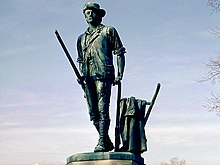
Daniel Chester French's monument, "The Minute Man," depicting the exemplary "Minute Man"
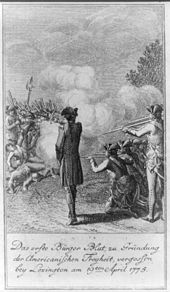
Battle of Lexington: British troops fire on the American militias
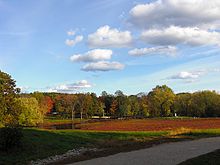
Rebuilt North Bridge at Minute Man National Historical Park
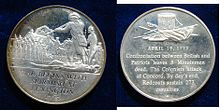
Franklin Mint Medal commemorating the start of the American War of Independence at Lexington and Concord in 1775.
Search within the encyclopedia